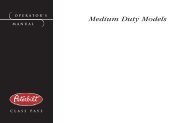Peterbilt Model 320 Operator's Manual after 8-07 - Peterbilt Motors ...
Peterbilt Model 320 Operator's Manual after 8-07 - Peterbilt Motors ...
Peterbilt Model 320 Operator's Manual after 8-07 - Peterbilt Motors ...
Create successful ePaper yourself
Turn your PDF publications into a flip-book with our unique Google optimized e-Paper software.
PART 8: MAINTENANCE AND SERVICE<br />
to do this, and must jump-start your vehicle, then ensure<br />
that you follow the precautions and instructions below.<br />
WARNING! Batteries contain acid that can burn<br />
and gasses that can explode. Ignoring safety<br />
procedures can cause you or others to be badly<br />
hurt.<br />
• Never jump start a battery near fire, flames, or<br />
electrical sparks. Batteries generate explosive<br />
gases. Keep sparks, flame, and lighted<br />
cigarettes away from batteries.<br />
• Do not allow battery fluid to contact eyes,<br />
skin, fabrics, or painted surfaces. Always<br />
wear eye protection. Battery acid that may<br />
spill during charging should be washed off<br />
with a solution of warm water and baking<br />
soda to neutralize the acid. If you accidentally<br />
get acid in your eyes or on your skin,<br />
immediately rinse with cold water for several<br />
minutes and call a doctor.<br />
• Be careful that metal tools or any metal in<br />
contact with the positive terminal do not<br />
contact the positive battery terminal and any<br />
other metal on the vehicle at the same time.<br />
Battery Care<br />
Remove metal jewelry; avoid leaning over<br />
a battery. If metal jewelry or other metal<br />
comes in contact with electrical circuits, a<br />
short circuit may occur causing you to be<br />
injured— plus electrical system failure and<br />
damage to the vehicle.<br />
• Do not try to jump start or charge a frozen<br />
battery. (Even a battery with ice particles on<br />
the electrolyte surface is dangerous.) Allow<br />
it to thaw out first. And always allow battery<br />
to thaw gradually—do not apply direct heat.<br />
Gas trapped in the ice may cause an explosion.<br />
• Do not try to jump start a vehicle if the electrolyte<br />
level in the battery of either vehicle is<br />
low. Maintain the full level of electrolyte in<br />
the batteries. This reduces the volume of gas<br />
in the cells.<br />
• The voltage of the booster battery must have<br />
a 12–volt rating. And the capacity of the<br />
booster battery should not be lower than<br />
that of the discharged battery. Use of batteries<br />
of different voltage or substantially<br />
different capacity rating may cause an explosion.<br />
To avoid serious personal injury and<br />
R(08/<strong>07</strong>) Y53-6015 – 173 –
















